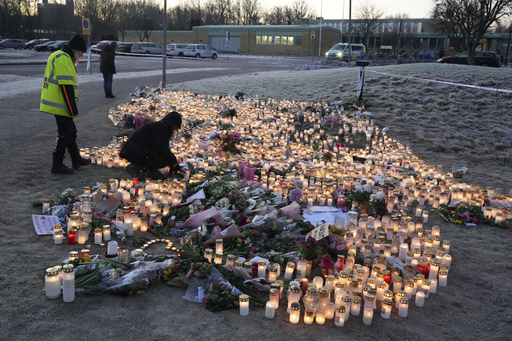
OREBRO, Sweden – In a tragic incident that marked Sweden’s deadliest mass shooting, Salim Karim Iskef, aged 28, managed to make a video call to his fiancée, Kareen Alia, while he was gravely wounded. During this final call, he expressed his love and asked her to look after both his mother and herself before the connection ended. When Alia attempted to call him back, there was no response, and she later learned that he succumbed to his injuries as one of ten victims fatally shot by a gunman on Tuesday at an adult education center in Orebro, where Iskef was pursuing a nursing degree. The couple had recently purchased a home and were making plans to marry this summer.
“He had all of these dreams in his heart. Now, unfortunately, all of these dreams are gone. Their light has been put out,” shared Father Jacob Kasselia, a priest at their local Orthodox Christian church, in remarks to TV4.
Authorities reported that the unidentified shooter was linked to the education center and used at least one firearm during the attack, suggesting he may have been a former student there. Later, the shooter was discovered deceased with three firearms, ten empty magazines, and a considerable quantity of unused ammunition beside him. It’s currently unclear how he met his end, although officials indicated that police did not return fire.
Among the victims, five individuals over the age of 18 sustained severe gunshot injuries, while a sixth was treated for lesser wounds. Investigators are still working to determine the motive behind the shooting, and police have noted a lack of any forewarning, believing the assailant acted solo. At this point, officials see no indications of any terrorist links to the incident.
Campus Risbergska, where the shooting occurred, serves adult learners over 20 and provides various programs ranging from vocational training to language classes for immigrants. Located on the outskirts of Orebro, approximately 200 kilometers (125 miles) from Stockholm, the institution has become a site of mourning following this assault.
Iskef had transitioned into nursing after serving as a health worker during the COVID-19 pandemic, having fled Syria with his family between 2014 and 2015 due to the ongoing civil strife. “We’ve lived together our entire lives,” his sister Hanan Eskif recounted. “My whole life was with him. How am I supposed to live without him?” The family held a memorial service at their church, although Iskef’s body had not yet been returned by late Thursday.
“We keep looking out the window thinking maybe he’ll return and knock on the door. We don’t sleep, we don’t eat, don’t drink. We just sit and look out,” Eskif added, struggling to cope with the loss.
In the wake of this tragedy, the government and Sweden Democrats announced plans to advance proposals aimed at tightening gun regulations, including limiting access to semi-automatic firearms like the AR-15. Authorities disclosed that the shooter legally owned four firearms, three of which were found at the scene; the fourth weapon is currently in police custody. At least one firearm identified was a rifle-like weapon.
To legally possess a firearm in Sweden, applicants must secure a weapon license and demonstrate its intended, acceptable use—like hunting or target shooting—while also providing evidence of prior hunting or shooting certifications. Applicants for hunting licenses are required to complete a training course, while target shooters must be recognized as active, experienced members of shooting clubs.
In a nation of roughly 10.5 million individuals, about 660,000 had registered to own firearms as of the beginning of 2024, with those owners possessing roughly 2 million guns and associated parts needing permits. A majority—1.6 million— were registered for hunting, with another 176,000 for target shooting. All firearms must be securely stored in cabinets approved by law enforcement, with permits for fully automatic weapons or handguns granted only under exceptional circumstances and largely time-restricted.
Permits are subject to revocation if firearms are modified significantly from their original design.

